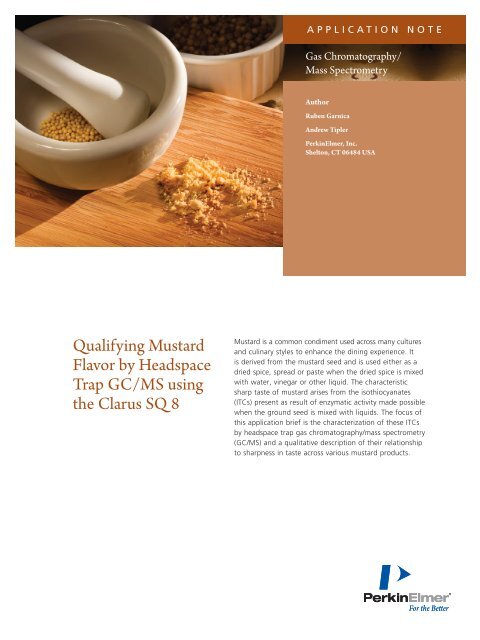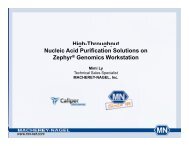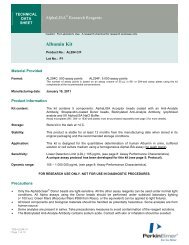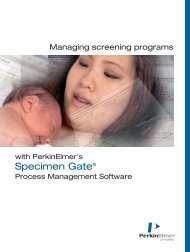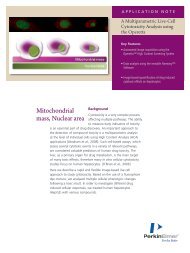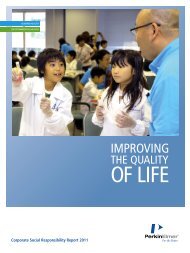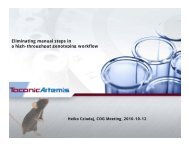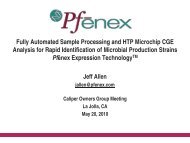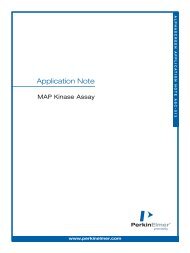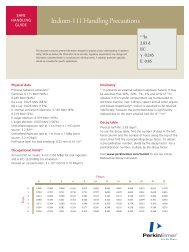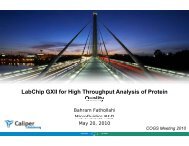Qualifying Mustard Flavor by Headspace Trap GC/MS ... - PerkinElmer
Qualifying Mustard Flavor by Headspace Trap GC/MS ... - PerkinElmer
Qualifying Mustard Flavor by Headspace Trap GC/MS ... - PerkinElmer
You also want an ePaper? Increase the reach of your titles
YUMPU automatically turns print PDFs into web optimized ePapers that Google loves.
application Note<br />
Gas Chromatography/<br />
Mass Spectrometry<br />
Author<br />
Ruben Garnica<br />
Andrew Tipler<br />
<strong>PerkinElmer</strong>, Inc.<br />
Shelton, CT 06484 USA<br />
<strong>Qualifying</strong> <strong>Mustard</strong><br />
<strong>Flavor</strong> <strong>by</strong> <strong>Headspace</strong><br />
<strong>Trap</strong> <strong>GC</strong>/<strong>MS</strong> using<br />
the Clarus SQ 8<br />
<strong>Mustard</strong> is a common condiment used across many cultures<br />
and culinary styles to enhance the dining experience. It<br />
is derived from the mustard seed and is used either as a<br />
dried spice, spread or paste when the dried spice is mixed<br />
with water, vinegar or other liquid. The characteristic<br />
sharp taste of mustard arises from the isothiocyanates<br />
(ITCs) present as result of enzymatic activity made possible<br />
when the ground seed is mixed with liquids. The focus of<br />
this application brief is the characterization of these ITCs<br />
<strong>by</strong> headspace trap gas chromatography/mass spectrometry<br />
(<strong>GC</strong>/<strong>MS</strong>) and a qualitative description of their relationship<br />
to sharpness in taste across various mustard products.
Method<br />
The experimental conditions for this analysis are given in<br />
Tables 1 to 4. The vials used are the standard 22-mL vials<br />
with aluminum crimped caps with PTFE lined silicon septa.<br />
Table 1. <strong>GC</strong> Conditions.<br />
Gas Chromatograph Clarus ® 680<br />
Column<br />
60 m x 0.25 mm x 1.0 µm Elite-5<strong>MS</strong><br />
Oven 35 °C for 5 min, then 6 °C/min to 245 °C<br />
Injector<br />
Programmable Split Splitless (PSS),<br />
180 °C, Split OFF<br />
Carrier Gas<br />
Helium at 2.0 mL/min<br />
(28.6 psig initial pressure), HS Mode ON<br />
Table 2. HS <strong>Trap</strong> Conditions.<br />
<strong>Headspace</strong> System TurboMatrix 110 HS <strong>Trap</strong><br />
Vial Equilibration 80 °C for 20 minutes<br />
Needle 120 °C<br />
Transfer Line 140 °C, long, 0.25 mm i.d. fused silica<br />
Carrier Gas<br />
Helium at 31 psig<br />
Dry Purge<br />
7 min<br />
<strong>Trap</strong><br />
CarboPack C, 25 °C to 260 °C, hold for 7 min<br />
Extraction Cycles 1 @ 40 PSI<br />
Results<br />
The total ion chromatogram obtained from French and<br />
British mustard samples are given in Figure 1. These intensity<br />
locked spectra demonstrated the higher level of ITCs present<br />
in British mustard as indicated <strong>by</strong> the larger peaks for allyl<br />
isothiocyanate (RT = 21.00 min) and 4-isothiocyanato-1-<br />
butene (RT = 24.28 min). This difference is indicative of the<br />
sharp verses smooth taste between British and French mustard.<br />
The large presence of ITCs shown in Figure 1 is contrasted<br />
with the total ion chromatogram obtained from ground<br />
mustard seed given in Figure 2. In general ground mustard<br />
seed lacks volatile flavor compounds because the enzymatic<br />
activation with liquid has not been performed. Figure 3<br />
demonstrates this activation with a comparison between dry<br />
British mustard powder and a reconstituted sample. In these<br />
labeled total ion chromatograms the intensity scales are<br />
locked between the spectrum and it is clear that activation<br />
with water has drastically increased ITC level in the reconstituted<br />
paste. The component identities were established<br />
<strong>by</strong> performing mass spectral library searches with the best<br />
match presented here. Peaks labeled with a single asterisk<br />
indicate detector overloading while peaks labeled with a<br />
double asterisk indicate inconclusive compound identification<br />
due to structural similarities.<br />
100<br />
21.00<br />
Table 3. <strong>MS</strong> Conditions.<br />
Mass Spectrometer Clarus ® SQ 8S<br />
Scan Range<br />
35 to 350 Daltons<br />
Scan Time<br />
0.1 s<br />
Interscan Delay 0.06 s<br />
Source Temp 180 °C<br />
Inlet Line temp 200 °C<br />
Multiplier<br />
1700V<br />
Table 4. Sample Details.<br />
Sample<br />
Sample Weight (g)<br />
<strong>Mustard</strong> Seed (ground) 0.50<br />
British <strong>Mustard</strong> Powder (dry) 0.50<br />
British <strong>Mustard</strong> Powder (reconstituted)* 1.00<br />
British <strong>Mustard</strong> 1.00<br />
French <strong>Mustard</strong> 1.00<br />
*reconstituted per manufacturer instructions<br />
%<br />
0<br />
100<br />
%<br />
6.64<br />
5.17 7.35<br />
8.78<br />
8.80<br />
Allyl Isothiocyanate<br />
11.04<br />
12.70<br />
12.73<br />
20.59<br />
20.96<br />
20.87<br />
4-isothiocyanato-1-butene<br />
5.18<br />
22.67<br />
0<br />
Time<br />
0.00 5.00 10.00 15.00 20.00 25.00 30.00 35.00 40.00<br />
Figure 1. Full total ion chromatogram obtained from French (top) and British<br />
(bottom) mustards.<br />
24.25<br />
24.28<br />
2
100<br />
%<br />
6.56<br />
Carbonyl Sulfide<br />
7.46<br />
4.72<br />
9.14 9.93<br />
5.21<br />
11.04<br />
General Lack of Volatile <strong>Flavor</strong> Compounds<br />
Conclusions<br />
This system provides a very simple and convenient way of<br />
characterizing the volatile flavor components of mustard<br />
based products. A rapid comparison between production<br />
samples may be made to monitor the enzymatic activation<br />
process and help producers arrive at the correct sharpness<br />
in taste. The combination of HS <strong>Trap</strong> with <strong>GC</strong>/<strong>MS</strong> allows for<br />
component detection at low-level concentration combined<br />
with the mass spectral compound identification.<br />
0<br />
5.00 10.00 15.00 20.00 25.00 30.00 35.00<br />
Time<br />
Figure 2. Full Total Ion Chromatogram obtained from mustard seed sample.<br />
100<br />
%<br />
Carbonyl Sulfide<br />
2-Butenenitrile**<br />
Allyl Isothiocyanate*<br />
2-Isothiocyanato-butane<br />
4-isothiocyanato-1-butene<br />
1-Isothiocyanato-3<br />
-methyl-butane<br />
22.69<br />
26.64 27.47<br />
4<br />
0<br />
100<br />
%<br />
0<br />
Ethanol<br />
6.55<br />
4.72<br />
Acetic Acid<br />
2-Butenenitrile**<br />
Allyl Isothiocyanate<br />
9.74 12.67<br />
α-Pinene<br />
β-Pinene<br />
20.97<br />
23.06<br />
24.58<br />
5.00 10.00 15.00 20.00 25.00 30.00 35.00<br />
Time<br />
Figure 3. Full total ion chromatogram obtained from British mustard powder<br />
(bottom) and reconstituted British mustard powder (top).<br />
<strong>PerkinElmer</strong>, Inc.<br />
940 Winter Street<br />
Waltham, MA 02451 USA<br />
P: (800) 762-4000 or<br />
(+1) 203-925-4602<br />
www.perkinelmer.com<br />
For a complete listing of our global offices, visit www.perkinelmer.com/ContactUs<br />
Copyright ©2011, <strong>PerkinElmer</strong>, Inc. All rights reserved. <strong>PerkinElmer</strong> ® is a registered trademark of <strong>PerkinElmer</strong>, Inc. All other trademarks are the property of their respective owners.<br />
009828_01


